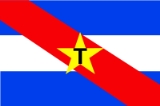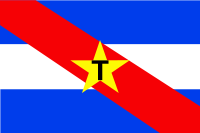
Tupamaros
Encyclopedia

Uruguay
Uruguay ,officially the Oriental Republic of Uruguay,sometimes the Eastern Republic of Uruguay; ) is a country in the southeastern part of South America. It is home to some 3.5 million people, of whom 1.8 million live in the capital Montevideo and its metropolitan area...
in the 1960s and 1970s. The MLN-T is inextricably linked to its most important leader, Raúl Sendic
Raúl Sendic
Raúl Sendic Antonaccio was a prominent Uruguayan Marxist and founder of the Tupamaros.Born in a rural area, near the village of Juan Jose Castro, in the Flores Department, Sendic worked with his father as a peasant on a crab apple farm until he finished high school and left his home to study in...
, and his brand of social politics. José Mujica
José Mujica
José Alberto "Pepe" Mujica Cordano is a Uruguayan politician and former guerrilla fighter, a member of the Broad Front and current President of Uruguay....
, current president of Uruguay, was also a member.
Creation
The Tupamaro movement was named after the IncaInca Empire
The Inca Empire, or Inka Empire , was the largest empire in pre-Columbian America. The administrative, political and military center of the empire was located in Cusco in modern-day Peru. The Inca civilization arose from the highlands of Peru sometime in the early 13th century...
revolutionary Túpac Amaru II
Túpac Amaru II
Túpac Amaru II was a leader of an indigenous uprising in 1780 against the Spanish in Peru...
. Its origins lie in the union between the Movimiento de Apoyo al Campesino (Peasant Support Movement) and the members of trade unions funded by Sendic in poverty-stricken rural zones.
The movement began by staging the robbing of banks, gun clubs and other businesses in the early 1960s, then distributing stolen food and money among the poor in Montevideo
Montevideo
Montevideo is the largest city, the capital, and the chief port of Uruguay. The settlement was established in 1726 by Bruno Mauricio de Zabala, as a strategic move amidst a Spanish-Portuguese dispute over the platine region, and as a counter to the Portuguese colony at Colonia del Sacramento...
. It took as slogan "Words divide us; action unites us."
At the beginning, it abstained from armed actions and violence; they have always made clear about not being a guerrilla group but a political movement; the eventual use of violent means would be made according to strategy and possibilities. In June 1968, President Jorge Pacheco
Jorge Pacheco Areco
Jorge Pacheco Areco was a Uruguayan politician and member of the Colorado Party. He served as President of Uruguay from December 6, 1967 to March 1, 1972.-Vice President of Uruguay:...
, trying to suppress labour unrest, enforced a state of emergency and repealed all constitutional safeguards. The government imprisoned political dissidents, used torture
Torture
Torture is the act of inflicting severe pain as a means of punishment, revenge, forcing information or a confession, or simply as an act of cruelty. Throughout history, torture has often been used as a method of political re-education, interrogation, punishment, and coercion...
during interrogations and brutally repressed demonstrations. The Tupamaro movement engaged then in political kidnappings, "armed propaganda" and assassinations. Of particular note are the kidnapping of powerful bank manager Pereyra Rebervel and of the British ambassador to Uruguay, Geoffrey Jackson
Geoffrey Jackson
Sir Geoffrey Holt Seymour Jackson, KCMG was a British diplomat and writer.Jackson received his education at Bolton School and Emmanuel College, Cambridge. He entered the Foreign Service in 1937, his first ambassadorship coming in 1957, a post in Honduras. In 1969, he became ambassador in Uruguay...
, as well as the assassination of Dan Mitrione
Dan Mitrione
Daniel A. Mitrione was an Italian-born American police officer, Federal Bureau of Investigation agent and a United States government advisor for the Central Intelligence Agency in Latin America.- Career :...
, the Federal Bureau of Investigation
Federal Bureau of Investigation
The Federal Bureau of Investigation is an agency of the United States Department of Justice that serves as both a federal criminal investigative body and an internal intelligence agency . The FBI has investigative jurisdiction over violations of more than 200 categories of federal crime...
agent documented to have taught techniques of torture to police forces in various Latin American countries. A very close friend to President Jorge Pacheco
Jorge Pacheco Areco
Jorge Pacheco Areco was a Uruguayan politician and member of the Colorado Party. He served as President of Uruguay from December 6, 1967 to March 1, 1972.-Vice President of Uruguay:...
, the banker Pereyra Rebervel was highly unpopular, having "once killed a newsboy for selling a paper attacking him." He was released four days later, unharmed but a bit fatter. According to Langguth, the "poor in Montevideo were quoted as joking, 'Attention, Tupamaros! Kidnap me!'".
The peak of the Tupamaros was in 1970 and 1971. During this period they made liberal use of their Cárcel del Pueblo (or People's Prison) where they held those that they kidnapped and interrogated them, before making the results of these interviews public. In 1971 over 100 imprisoned Tupamaros escaped the Punta Carretas prison. In the same year, in an uncleared(?) episode, Pascasio Báez, a rural laborer that accidentally discovered one of their hideouts was killed.
Nonetheless, the movement was hampered by a series of events including important strategic gaffes and the betrayal of high-ranking Tupamaro Héctor Amodio Pérez, and the army's counteroffensive, which included the Escuadrón de la Muerte (Death squad
Death squad
A death squad is an armed military, police, insurgent, or terrorist squad that conducts extrajudicial killings, assassinations, and forced disappearances of persons as part of a war, insurgency or terror campaign...
), police officers who were granted repressive powers to deal with Tupamaros.
Along with police forces trained by the US Office of Public Safety
Office of Public Safety
The Office of Public Safety was a US government agency, established in 1957 by US President Dwight D. Eisenhower to train police forces of US allies. It was officially part of USAID , and was close to the Central Intelligence Agency . Police-training teams were sent to South Vietnam, Iran, Taiwan,...
(OPS), the Uruguayan military unleashed a bloody campaign of mass arrests and selected disappearances, dispersing those guerrillas who were not killed or arrested. Their usage of torture was particularly effective, and by 1972 the MLN-T had been severely weakened. Its principal leaders were imprisoned under terrible conditions for the next 12 years.
Despite the diminished threat, the civilian government of Juan María Bordaberry
Juan María Bordaberry
Juan María Bordaberry Arocena was a Uruguayan politician and cattle rancher, who first served as President from 1972 until 1976, including as a dictator from 1973 until his ouster in a 1976 coup...
ceded government authority to the military in July, 1973 in a bloodless coup that led to further repression against the population and the suppression of all parties. The following month, the Tupamaros formed the Revolutionary Coordinating Junta
Revolutionary Coordinating Junta
The Revolutionary Coordinating Junta or JCR was an alliance of leftist South American guerrilla organizations in the mid 1970s...
with other leftwing groups pursuing urban guerrilla warfare
Urban guerrilla warfare
Urban guerrilla redirects here. For the Hawkwind song, see Urban Guerrilla.Urban guerrilla refers to someone who fights a government using unconventional warfare in an urban environment...
in the Southern Cone
Southern Cone
Southern Cone is a geographic region composed of the southernmost areas of South America, south of the Tropic of Capricorn. Although geographically this includes part of Southern and Southeast of Brazil, in terms of political geography the Southern cone has traditionally comprised Argentina,...
. The following year, various South America
South America
South America is a continent situated in the Western Hemisphere, mostly in the Southern Hemisphere, with a relatively small portion in the Northern Hemisphere. The continent is also considered a subcontinent of the Americas. It is bordered on the west by the Pacific Ocean and on the north and east...
n regimes responded with the collaborative, international counterinsurgency campaign known as Operation Condor
Operation Condor
Operation Condor , was a campaign of political repression involving assassination and intelligence operations officially implemented in 1975 by the right-wing dictatorships of the Southern Cone of South America...
.
List of attacks
- 31 July 1970 - Unsuccessful kidnap attempt on U.S. Foreign Service officer Michael Gordon JonesGordon JonesGordon Jones was an American character actor who became best known as The Green Hornet in the first of two movie serials based on that old-time radio program....
. - 31 July 1970 - Kidnapping of USAID public safety advisor, former Indiana police officer Dan MitrioneDan MitrioneDaniel A. Mitrione was an Italian-born American police officer, Federal Bureau of Investigation agent and a United States government advisor for the Central Intelligence Agency in Latin America.- Career :...
, murdered on 10 August 1970. - 31 July 1970 - Kidnapping of the Brazilian consul Aloysio Mares Dias Gomides, released on 21 February 1971 for ransom ($250,000).
- 7 August 1970 - Kidnapping of U.S. agronomist Dr. Claude Fly, released on 21 March 1971.
- 29 September 1970 - Bombing of the Carrasco Bowling, gravely injuring the elderly caretaker Hilaria Ibarra (rescued from the rubble by Gustavo Zerbino who would later be a survivor in the Andes disaster).
- 8 January 1971 - Kidnapping of the British ambassador Geoffrey JacksonGeoffrey JacksonSir Geoffrey Holt Seymour Jackson, KCMG was a British diplomat and writer.Jackson received his education at Bolton School and Emmanuel College, Cambridge. He entered the Foreign Service in 1937, his first ambassadorship coming in 1957, a post in Honduras. In 1969, he became ambassador in Uruguay...
, released after eight months for ransom (₤42,000). - 21 December 1971 - Killing of rural laborer Pascasio Báez by sodium pentothal injection
- 18 April 1972 - Four soldiers killed by machine gun fire while watching over the house of the commander-in-chief of the Army, General Florencio Gravina.

